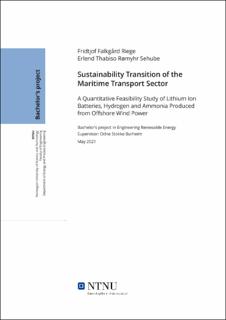| dc.contributor.advisor | Burheim, Odne Stokke | |
| dc.contributor.author | Riege, Fridtjof Falkgård | |
| dc.contributor.author | Sehube, Erlend Thabiso Rømyhr | |
| dc.date.accessioned | 2021-09-21T16:01:29Z | |
| dc.date.available | 2021-09-21T16:01:29Z | |
| dc.date.issued | 2021 | |
| dc.identifier | no.ntnu:inspera:81240705:83730777 | |
| dc.identifier.uri | https://hdl.handle.net/11250/2779951 | |
| dc.description.abstract | Klimaendringer og miljøødeleggelser er en eksistensiell trussel for kloden. 97% av forskere er enig at temperaturøkningen er et resultat av menneskers klimagassutslipp. Dette er en økende bekymring blant politikere, arbeidsgivere og mennesker i samfunnet generelt. Den maritime transportsektoren står for 3% av det menneskeskapte CO2-utslipp. En bærekraftsomstilling i denne sektoren kan derfor være en avgjørende faktor i å nå klimamålene satt i Parisavtalen, samt andre organisasjoner.
En kvantitativ analyse om hvorvidt hydrogen, Li-ion batterier og ammoniakk produsert fra offshore vindkraft, kan være gjennomførbare alternativ som drivstoff i maritime skip. Denne studien tar for seg de teknologiske og fysiske mulighetene og utfordringene dette vil medføre, samt miljøvirkningene av dette. For å studere et bredt spekter av ulike skip, blir de fornybare drivstoffene studert opp mot egenskapene til et cargoskip, ferje og hurtigbåt. For å kunne gi et klart svar på om bruken av hydrogen, Li-ion batterier eller ammoniakk er gjennomførbare alternativ, er den økonomiske virkningen, samt andre faktorer ut over de begrensningene som er satt i denne oppgaven, vurdert som essensielle. Funnene og konklusjonen for denne oppgaven er derfor tiltenkt å være indikasjon på gjennomførbarheten og ikke et definitivt svar.
En grundig analyse av egenskapene til hvert drivstoff, begrensningene til hvert skip og miljøvirkningene av hvert drivstoff er gjennomført. Informasjonen er hovedsakelig basert på en litteraturstudie av disse variablene. Egenskapene til hvert drivstoff og begrensningene til hvert skip ble analysert ved å implementere verdiene i Microsoft Excel, og deretter beregne ulike faktorer som kan påvirke evalueringen av gjennomførbarheten til disse drivstoffene. Basert på de utregnede faktorene, er det lagt frem et forslag til hvilke drivstoff som kan være gjennomførbare i hvert skip. Det er konkludert med at hydrogen er gjennomførbart som drivstoff i hurtigbåter, med en mulig reduksjon av global oppvarmingseffekt på minst 84%. Bruken av Li-ion batterier konkluderes med å være gjennomførbart som drivstoff i ferjer, med en mulig reduksjon av global oppvarmingseffekt på minst 60%. Bruken av ammoniakk konkluderes med å være gjennomførbart som drivstoff i cargo skip, med en mulig reduksjon av global oppvarmingseffekt på minst 69%. | |
| dc.description.abstract | Climate change and environmental degradation are an existential threat to the world. 97% of scientists agree that the temperature is rising as a result of human activities such as greenhouse gas emissions. This is a growing concern amongst politicians, business leaders and people in general. The maritime transport sector is responsible for around 3% of the world's anthropogenic CO2-emissions. A sustainability transition of this sector, could therefore be a crucial factor in reaching objectives set by The Paris Agreement, as well as other organizations.
A quantitative analysis of hydrogen, Li-ion batteries, and ammonia produced by offshore wind power is presented in this thesis, with the aim of analyzing their feasibility as fuels in maritime applications. This study describes the technological and physical opportunities and challenges it may present, as well as the environmental footprint. With the purpose of analyzing a broad spectrum of ships in the sector, the renewable fuels are analyzed based on the attributes in a cargo ship, passenger ferry and high-speed craft. In order to give a conclusive answer to if the use of hydrogen, Li-ion and ammonia are feasible alternatives, the financial feasibility and aspects beyond this thesis's limitation are considered as essential. This thesis's findings and conclusion are therefore meant to be regarded as indicative rather than definite.
A thorough analysis of the properties of each fuel, requirements of each ship and the environmental footprint of the fuels are conducted. The information is mainly retrieved by a literature study on the different aspects. The properties of each fuel and the requirements of each ship were analyzed by implementing the values in Microsoft Excel, and thereby calculating several factors that could affect the assessment of the utilization of the given fuels.
Based on the factors that are established, a proposal of which fuel could be feasible in each ship. It is concluded that the utilization of hydrogen is feasible as fuel in high-speed crafts, and could reduce the global warming potential by at least 84%. It is concluded that the utilization of Li-ion batteries is feasible as fuel in passenger ferries, and could reduce the global warming potential by at least 60%. It is also concluded that the utilization of ammonia is feasible in cargo ships, and could reduce the global warming potential by at least 69%. | |
| dc.language | eng | |
| dc.publisher | NTNU | |
| dc.title | Sustainability Transition of the Maritime Transport Sector | |
| dc.type | Bachelor thesis | |
